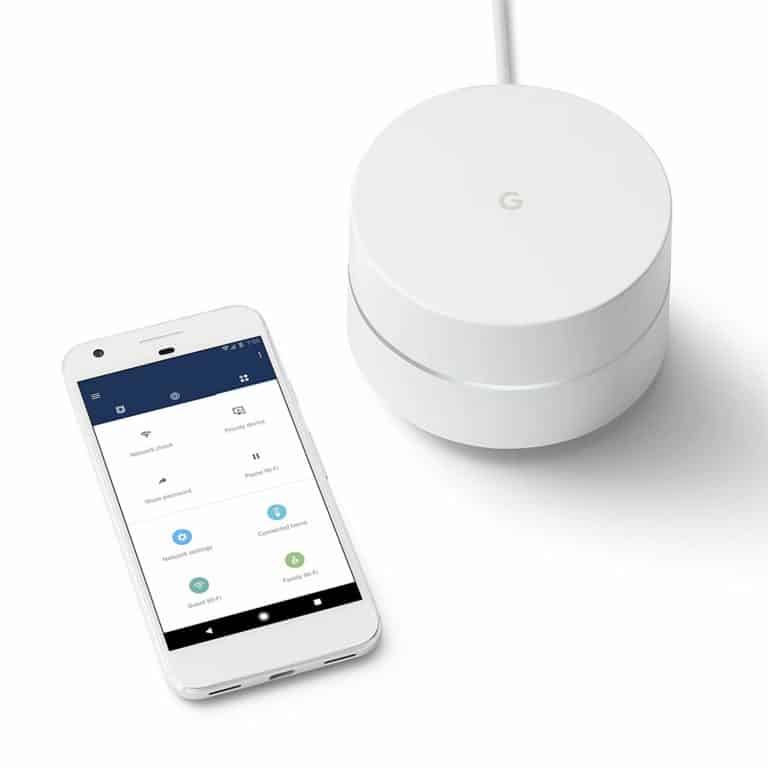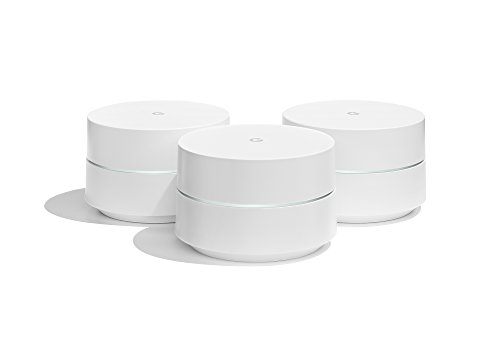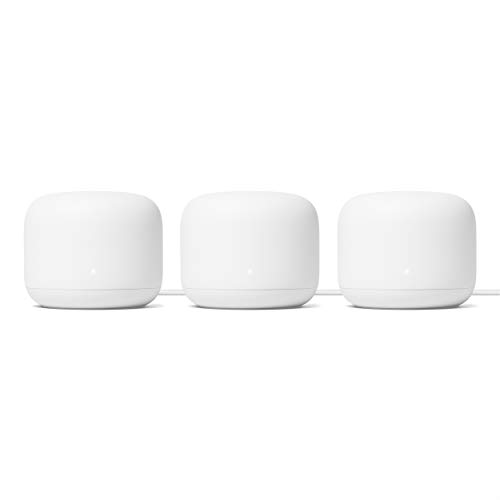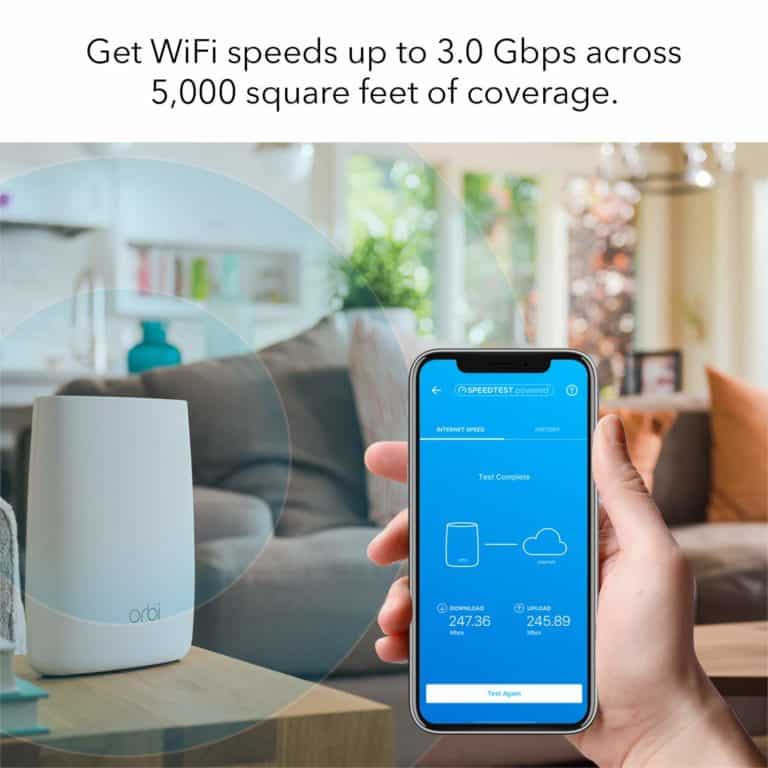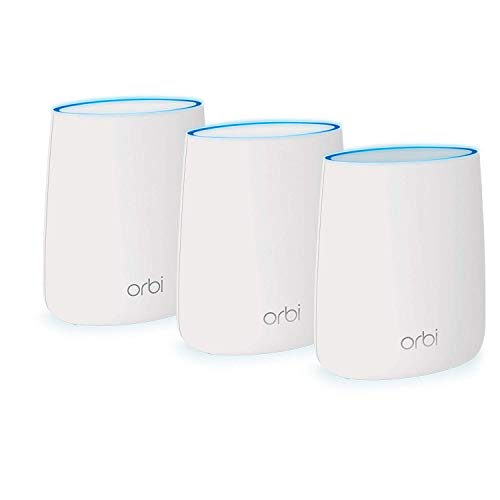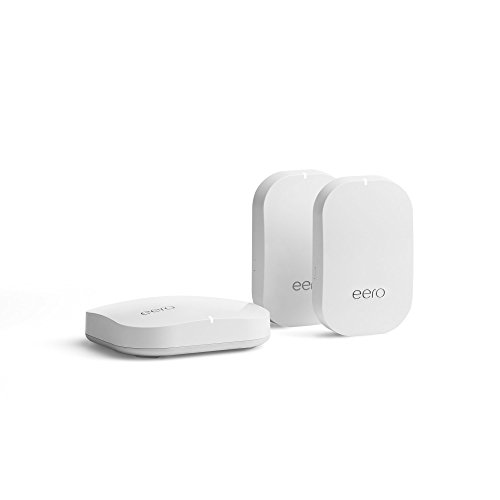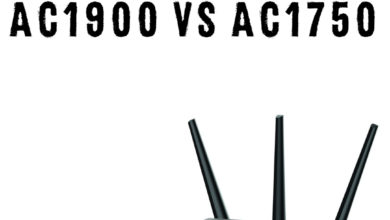Google WiFi vs Nest vs Orbi vs Eero vs Velop
This article will compare the best mesh Wi-Fi routers and weigh up Google WiFi vs Nest WiFi vs Orbi vs Eero vs Velop. The reality of all these mesh networks is that they contain very similar hardware and offer very similar specs. Your purchasing decision will most likely come down to any brand preference you have or your budget.
Home Wi-Fi systems don’t flash off impressive features or immersive experiences like other tech does. However, it is the backbone of the modern-day world with huge importance in the household. As media quality improves and data volume increases, the need for the fastest, most reliable, most secure and most response Wi-Fi system grows. From your laptop to your Amazon Echo, having the latest and best Wi-Fi technology can give you a better user experience across the whole of your home.
Contents
Best Mesh Wi-Fi Comparison Chart
| Model | Google WiFi | Nest WiFi | Eero | Orbi | Velop |
|---|---|---|---|---|---|
| Design |  |  | 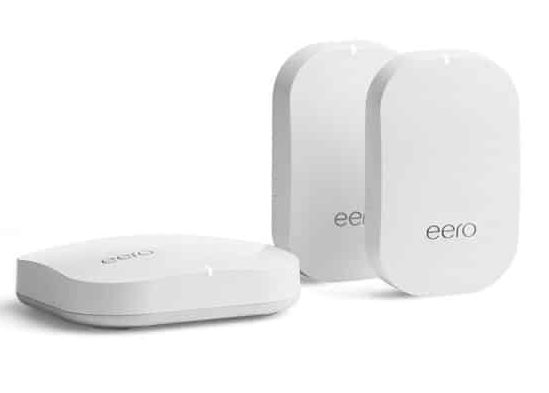 | 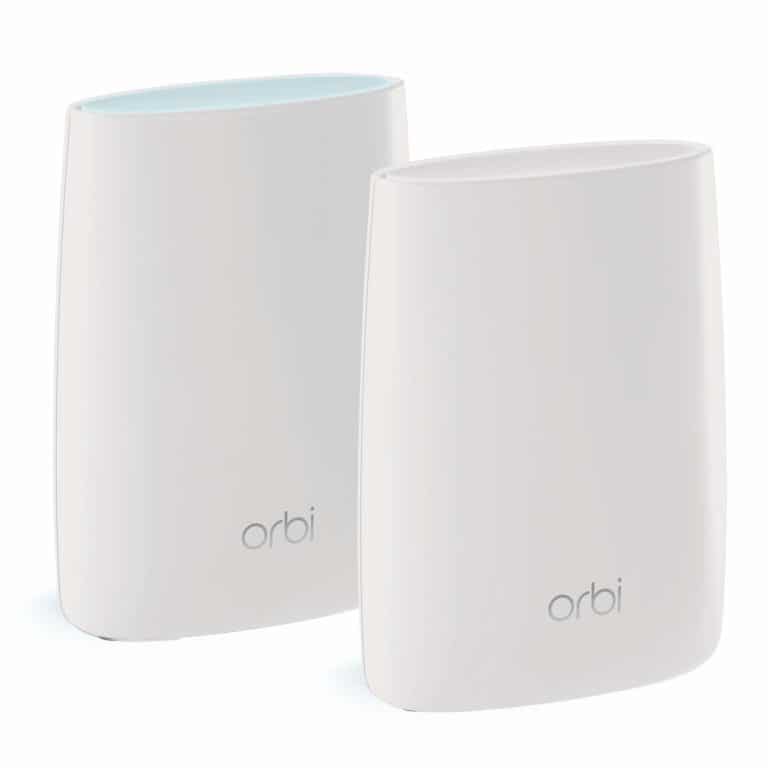 | 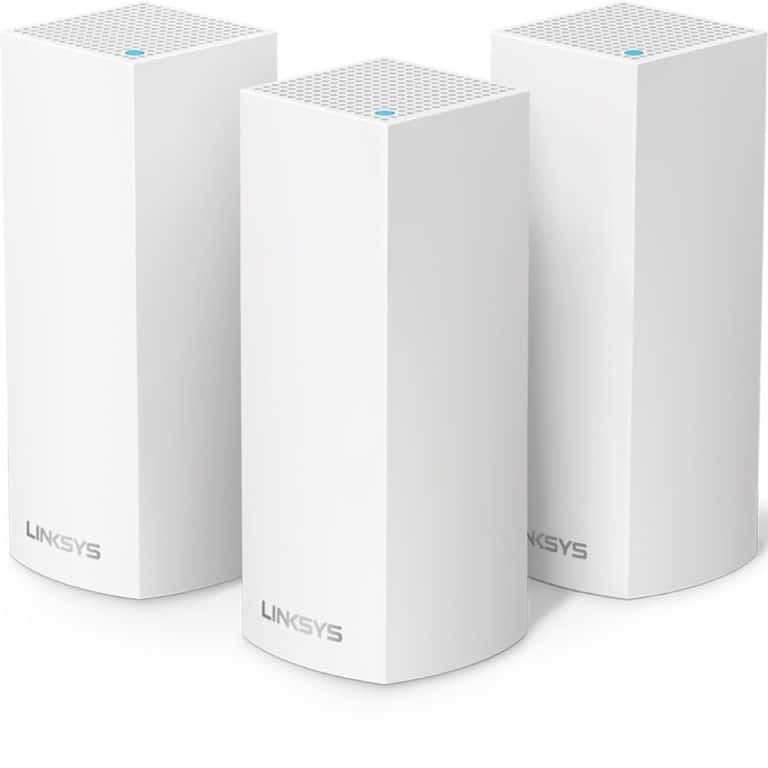 |
| Wireless Specs | -AC1200 2×2 Wave 2 Wi-Fi -Expandable mesh Wifi -Simultaneous dual-band Wifi (2.4 GHz/5 GHz) -Supporting IEEE 802.11a/b/g/n/ac -Bluetooth® Smart Ready | -AC2200 MU-MIMO Wi-Fi 4x4 (5 GHz) 2x2 (2.4 GHz) -Simultaneous dual-band (2.4 GHz/5 GHz) Wi-Fi -supporting IEEE 802.11a/b/g/n/ac | -Tri-band WiFi 2.4GHz, 5.2GHz, and 5.8GHz -wireless2x2 MU-MIMO -IEEE 802.11a/b/g/n/ac | -802.11ac/TTri-band WiFi technology -MU-MIMO -4X4 (1.7Gbps) dedicated backhaul -6 high-performance antennas | -Tri-Band AC2200 (867 + 867 + 400 Mbps)‡ -MU-MIMO -256 QAM -Simultaneous Tri-Band (2.4Ghz + 5GHz + 5GHz) |
| Beamforming | ✔ | ✔ | ✔ | ✔ | ✔ |
| Ports | 2 Gigabit | 2 Gigabit | Two auto-sensing Gigabit ports for WAN and/or LAN connectivity | Router – 1 WAN & 3LAN Satellite – 4 WAN USB 2.0, power | 2x WAN/LAN auto-sensing Gigabit Ethernet ports |
| Ram | 512 MB | 1 GB | 512 MB | 512 MB | 512 MB RAM |
| Flash Storage | 4 GB | 4 GB | 4 GB | 4 GB | 4 GB |
| Processor | Quad-core ARM 710MHz | Quad-core 64-bit ARM CPU 1.4 GHz | Quad-core ARM 700MHz | Quad-core ARM 710MHz | Quad-core ARM 716MHz |
| Smart Speaker | ✔ | ||||
| Bottom Line | Good Customer Support | All Round Best | Solid Speeds | Good for Gaming | Good Long Distance Performance |
| Availability | Check Price | Check Price | Check Price | Check Price | Check Price |
Head to Head Comparison
Coverage: Although there is a small variation in the coverage of each of these mesh network systems, they will reach every corner of most homes. It is possible to add in more nodes with all brands at similar pricing. Here are the quoted ranges of each brand:
- Google WiFi: 1,500 square feet.
- Nest WiFi: 2,200 square feet.
- Netgear Orbi: 2,500 square feet.
- Amazon Eero Pro: 1,750 square feet.
- Linksys Velop: 2,200 square feet.
Performance: Over a LAN network, these devices can output speeds far greater than what is currently required with a live internet connection from an ISP. All of these mesh network systems will handle commercially available internet speeds. The Google Nest WiFi is the fastest router across a shorter and further range. However, not far behind is Velop at further distances or Eero at short distances.
Hardware: The hardware and tech specs contain all the same major pieces of kit in areas ranging from Wi-Fi type to security.
App Control: This is another area where every brand ticks the boxes in regards to ease of use for setup, control, and monitoring. As you would expect, the top choice would have to be Google WiFi or Nest WiFi for its exceptional intuitive ease of use.
Customer Satisfaction: Although some users get smooth and quality experiences which fit the manufacturer’s promises, it is very important to consider customer satisfaction, This is one of the most insightful factors that should inform your decision. On the whole, these are all well-reviewed products compared to other areas of tech. Nest WiFi and Amazon Eero are the two leading choices here.
Price: Of course, the price of each unit is a particularly important aspect that can’t be overlooked. Nest WiFi is understandably the most expensive as it is the most advanced. Google WiFi is now the cheapest as it has been upgraded and made a little out of date.
Google WiFi

The worlds leading tech giant is dipping its toes in many markets at the moment. The Google WiFi mesh system was released at the end of 2016 and is their only Wi-Fi router network available. The routers are available in a pack of either one, two or three modules. We all know that Google produces the most impressive hardware and software in the world. It is no surprise that their Google WiFi system is one of the best. Whether you are team Google, Apple or Amazon, the specs and performance of the Google WiFi system can’t be denied. A strong sense of simplicity with high performance is the message from these devices, a contrasting and competing set of characteristics which make it the device it is.
Design & Setup
The design is a particularly minimal white with a small matted “G” on the top to label its maker. There is a horizontal ring around the edge which has a soft blue light to indicate function. Each Wi-Fi point two Gigabit Ethernet ports and a power supply. The Google WiFi system has the easiest setup of any of the mesh routers on the market. The Google WiFi App hosts the wizard setup and simply requires you to scan the QR codes of any of your WiFi points. Set your network username and password then you are good to go. The dimensions are of each node is as follows:
- Diameter: 106.1 mm (4.1 in)
- Height: 68.7 mm (2.7 in)
- Weight: 340g
Specs
Wireless
- AC1200 2×2 Wave 2 Wi-Fi
- Expandable mesh Wi-Fi
- Simultaneous dual-band Wifi (2.4 GHz/5 GHz) supporting IEEE 802.11a/b/g/n/ac
- TX Beamforming
- Bluetooth® Smart Ready
Ports
- Two Gigabit Ethernet ports per Wifi point
Memory
With one WiFi Point, you can cover up to 85 square meters, two gets you anywhere from 85-170 square meres whilst three is appropriate for those who need to cover 170-420 square meters. You can use as any WiFi points as you want, but you will rarely need more than six. Google WiFi does not have the most cutting-edge hardware and eye-opening speeds. It does, however, offer one of the most reliable speeds over the whole mesh network. Over a Local Network (LAN), you can expect to get around 450 - 500Mbps speed. With a 100Mbps service from an ISP, many users have reported speeds maximizing or even exceeding this (up to 100Mbp). Google WiFi can maintain speeds within 100 ft fairly decently, but this can drop off beyond this.
Google Nest WiFi

Google has upped its mesh Wi-Fi game by releasing the Google Nest WiFi at the end of 2019. Taking on the Nest Labs branding, who is owned by Google, this mesh Wi-Fi system is a considerable upgrade from the original. In addition to being a Wi-Fi router, each mesh unit also has a smart speaker and Google Assistant support. With a 360 degree speaker and a microphone, each Nest WiFi unit is effectively a Google Home Mini as well. Using the Wi-Fi it provides, it can stream music, answer your questions, make calls and much more. In addition to these extra features, the router itself is quite a bit better than the original as it delivers faster speeds being an AC2200 router. Google claims it can have up to 100 devices operating on the network at one time. We compare the Nest WiFi vs Google WiFi in more detail in another article.
Design & Setup
The design of the Google Nest WiFi is a little more aesthetic than the original version. Rather than being a little hard-edged, it is a smooth dome shape but still following the minimalistic styling Google goes for. It is also slightly heavier and larger. Another subtle yet good improvement is the branded Google “G” on the top is imprinted rather than printed. The dimensions of each Google Nest unit is as follows:
- Diameter: 110 mm (4.33 inches)
- Height: 90.4 mm (3.55 inches)
- Weight: 380 g
As this mesh Wi-Fi is just an upgrade from Google WiFi, the setup process has been designed to be simple. The process involves downloading the Google Home app, running through the configuration, plugging your routers in and setting up new devices using the QR code scanning system.
Specs
Wireless
- AC2200 MU-MIMO Wi-Fi
- 4×4 (5 GHz)
- 2×2 (2.4 GHz)
- IEEE 802.15.4 Thread (2.4 GHz)
- TX Beamforming
- Bluetooth® Low Energy
Ports
- Dual Gigabit Ethernet ports
- Barrel jack power
Memory
Netgear Orbi

Netgear is one of the most established Wi-Fi router manufacturers and a prominent figure in the tech industry. They have much expertise in not just wireless routers but also wireless cameras as seen in their Arlo cameras. When it came to producing their mesh Wi-Fi system, they have successfully applied their wireless capabilities in order to produce a reliable product. Where the Netgear Orbi sticks out is the impressive hardware specs and very fast speeds. This mesh network is different from the Google WiFi in that it has a main router with accompanying Orbi Satellites. It is the satellites that provide the mesh function, which effectively achieves the same goal but through very slightly different means.
Design & Setup
The Netgear Orbi Satellite is a minimal design white with a blue light ring, although it is on the top of the device. It’s a relatively long and thin oval shape with a larger surface area that is more visible to the eye. The router that connects to your modem is styled just like a simple black router. The process of setting up the Orbi mesh network can be done with either the Orbi app or by plugging in a PC or Mac to directly into the router with either net. You will be asked to make a name for the network and a password for access. Once the network has been established you simply plugin and turn on your Orbi satellites and your router will find them. All in all, the process is completed in six steps. The dimensions and weight of each Satellite are as follows:
- Dimensions: 6.7 x 3.1 x 8.89 inches
- Weight: 1.96lb (890.5g) each
Specs
Wireless
- 802.11ac/TTri-band Wi-Fi technology
- MU-MIMO
- Beamforming
- 4X4 (1.7Gbps) dedicated backhaul
- 6 high-performance antennas
Ports
- Router - 1 WAN & 3LAN
- Satellite - 4 WAN
- USB 2.0, power
Memory
Orbi App
The Orbi app is a point of control of your mesh network beyond just setting up your devices. From the app, you can manage your routers and other devices, view the status of your Orbi devices and enforce parental controls with a program called Circle that works with Disney. You can also run speed tests, pause the internet and view your usage over a time period. You may also create a Wi-Fi network for guests, similar to the Google WiFi app.
Coverage & Performance
With a router and the two included Orbi Satellites, you can cover up to 5,000 square feet or 464.50 square meters. With an additional Orbi Satellite, you can reach 7,500 feet or 696.7 square meters. Orbi has some of the most on-point hardware components and the best performance out of the mesh networks Over a Local Network (LAN), you can expect to get around 550 Mbps speed. It also manages to maintain speeds relatively well when exceeding 100 feet. Accordingly, those gamers may want to consider this option if they need fast streaming speeds.
eero Pro (2nd Gen)
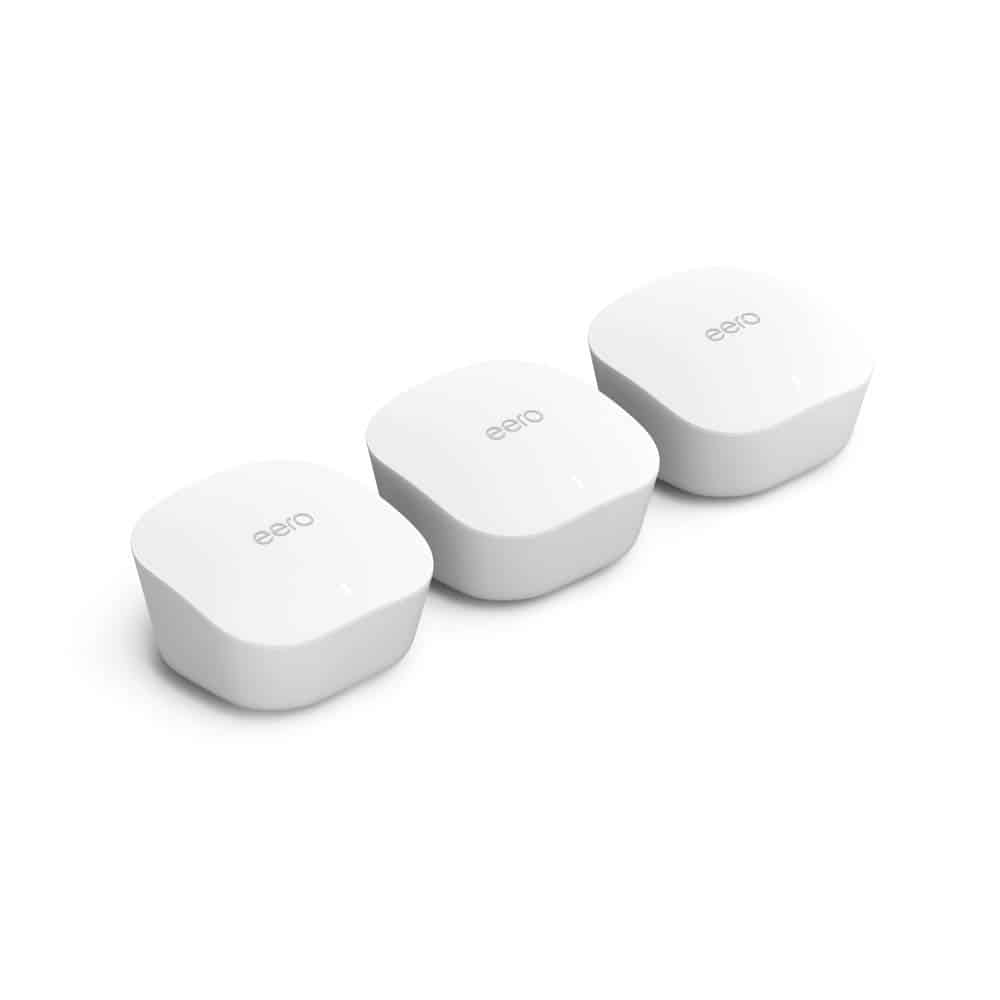
The Amazon eero Pro WiFi system is a mesh network that is comprised anywhere between two and three devices. There are a couple of offerings from eero that a slightly different. First you have the eero Home WiFi System that is an eero router with an additional one or two Beacons. The eero has ethernet ports whilst Beacons do not, hence one is Wi-Fi generating whilst the other just relays the signal. The second option is the eero WiFiPro System, which is a pack of three eeros sold together, without Beacons. Inevitably, the WiFi Pro System will be that bit tighter and faster than the system with the Beacons, especially if the area is larger.
Design & Setup
The design of the eero Home WiFi system follows the standard that is seen with mesh Wi-Fi systems. The box is a white with a single light to show it’s operating with a small eero logo imprinted on it. Setup of the eero Wi-Fi system is straightforward and mediated via the eero app, as per usual with mesh networks. Opening the app will run the setup wizard where some basic questions such as the layout of your home are asked. You then need to connect the eero (not a Beacon) to the modem and then you just need to add the Beacons to the network as instructed by the app. The weight an dimensions of the eero are as follows:
- Dimensions: 4.8 x 1.2 x 4.8 inches
- Weight: 240g
Specs
Wireless - eero
- Tri-band Wi-Fi radios, simultaneous 2.4GHz, 5.2GHz, and 5.8GHz wireless2x2 MU-MIMO, beamforming, IEEE 802.11a/b/g/n/ac
- Thread 1.1 Border Router, Bluetooth® LE 4.2
- WPA2 encryption, Family Profiles, DHCP, IPV6, NAT, VPN Passthrough, UPnP, Static IP, and Port Forwarding
Wireless - eero Beacon
- Dual-band Wi-Fi radios, simultaneous 2.4GHz and 5GHz wireless
- 2×2 MU-MIMO, beamforming, IEEE 802.11a/b/g/n/ac
- Thread 1.1 Border Router, Bluetooth® LE 4.2
- WPA2 encryption, Family Profiles, DHCP, IPV6, NAT, VPN Passthrough, UPnP, Static IP, and Port Forwarding
Ports
- Two auto-sensing Gigabit ports for WAN and/or LAN connectivity
Memory
eero is less specific with their promised coverage you can get with their mesh network. Rather than presenting an exact footage, they state that their eero Pro WiFi System (with 3 eeros) will cover a household with five or more bedrooms. Their most simple package with an eero and one Beacon covers a one to two-bedroom house. Their middle package can cover a three to four-bedroom house. Whilst this guide is not specific it at least offers some guidance. When it comes to delivering the end product, speedy and reliable Wi-Fi, eero is one of the strongest competitors. The eero mesh network is speedy at both shorter and longer distance, making it one of the best performing mesh Wi-Fi router. Over a Local Network (LAN), you can expect to get 600Mbps.
Linksys Velop

The Linksys Velop is our final mesh network in our comparison. As you have gathered, as Wi-Fi is a relatively one-dimensional product, everything from the design, features, and performance have been similar across the comparison. It won’t be a surprise the Linksys Velop follows the standards we have seen in mesh network systems. Just like the others, they are sold in flexible packages either as one, two or three. If there is one area where Linksys Velop sticks out, it is the ability to deliver the best speeds at a further distance.
Design & Setup
The Linksys Velop units again have a white style with a grey Linksys logo. These are rather differently styled in regards to shape and size compared to the other units. Rectangular, much taller and less compact, these units are bulkier than the other mesh routers we have overviewed above. They also a little bit heavier, although this shouldn’t weigh in as a problem. The setup is quick and comprised of a few stages that mirror the other brands. The first step is to setup the primary node or Parent by using the Linksys app instructions. Following that you simply connect the other nodes to the Parent node wirelessly.app. Dimensions and weight are as following:
- Dimensions: 3.1 x 3.1 x 7.3 inches
- Weight:630g
Specs
Wireless
- Tri-Band AC2200 (867 + 867 + 400 Mbps)‡
- with MU-MIMO and 256 QAM
- Simultaneous Tri-Band (2.4Ghz + 5GHz + 5GHz)
- Beamforming for 2.4 GHz and 5GHz bands
- WPA2 personal
Ports
- 2x WAN/LAN auto-sensing Gigabit Ethernet ports
Memory
A single Linksys Velop is suitable for a small living of around 2000 square feet and one or two bedrooms. Two Velops will have you covered in a 4,000 square feet area or three to four bedrooms. Finally, three Velops will cover up to a 6,000 square feet area and five or more bedrooms. The Linksys Velop has solid speeds, especially at the furthest range where it is the fastest. Over a Local Network (LAN), you can expect to get up to 550-500 Mbps. The Velops is very solid at the furthest distances, at 100 ft or over where it can maintain up to half its maximum speed.
Final Word
Mesh routers are relatively one-directional yet complex devices. This is reflected by the similarity of the hardware used and the results produced by these top mesh network systems. The speeds, coverage and app are all at the same level of quality between the Google WiFi, Orbi, eero and Velop. When taking into account every feature, Google Nest WiFi is the best overall mesh network. The tech giant magic touch in simplicity, quality, and premier software and hardware give the best all rounded system. Although other mesh routers have faster maximum speeds, this is unlikely to make a difference when using typical ISP speeds. Coverage among all brands is equal as the addition of more nodes will eliminate any performance issues. Google WiFi also has the easiest use and cleanest app.
Mesh WiFi Showdowns
In this section we will do a quick overview comparing these popular choices of the best mesh Wi-Fi systems head to head.
Orbi vs Velop?
Neatgear’s Orbi and Velop have different benefits going for them. For one, Velop has great speeds at longer distances, almost as good as Nest WiFi. However, Orbi does cover a significiantly larger area with 2 unites, 5,000 square feet over Velops 4,000. They are similarly priced although Velop is a little cheaper. Overall, we would suggest Orbi as it is a more established brand with more consistent customer ratings.
Orbi vs Eero Pro?
Amazon Eero is a better choice than Orbi due to similar specs but a cheaper price. For one, Eero is faster than Orbi, particularly at shorter distances. The customer support is particularly good and with an Eero router, you can expect frequent firmware updates to keep your router secure and running smoothly. Another neat feature of an Amazon Eero purchase is the inclusion of a free Echo Dot.
Velop vs Eero Pro?
Again, Amazon Eero is the victor here. The reasons for Eero’s victory are the same as before, a great price to performance ratio, superb customer support, and regular firmware updates. Going with team Amazon is a solid choice when it comes to smart home technology. The only situation where Velop may be better is if someone knows they will use the further distances more. This is because Velop covers a wider area and has consistently faster speeds at these distances.
Google WiFi vs Eero Pro?
Google WiFi is a little outdated now and we would firmly back Amazon Eero over it. The performance and range of Eero is better, especially at the shortest distances. However, the customer support and companion app of Google WiFi is pretty decent. We would recommend anyone wanting a Google product to choose the Nest WiFi over Google WiFi as it’s much newer and better. However, Google WiFi is much cheaper than Eero.
Google WiFi vs Orbi?
For a better range and faster speeds this also has to go Orbi. Again, the same sentiment as our previous comparison; Google WiFi is a little outdated now.
Nest WiFi vs Eero Pro
Nest WiFi is the most advanced mesh Wi-Fi system with the best speeds across all distances. However, Nest WiFi is the most expensive. The Eero Pro isn’t that far behind on speed, in fact, at shorter distances, it is very close to the speed of Nest WiFi. Eero also has some of the best customer support as you would expect given its an Amazon device.
FAQ
These questions are more tailored to answer questions specific to this comparison of the brands eero, Google WiFi, Nest Orbi and Velop.
Is mesh Wi-Fi better than a router?
Mesh Wi-Fi systems are only better than regular routers if you want to cover a larger area in your home. In general, the highest spec routers are better than Mesh Wi-Fi routers at a shorter distance.
Does mesh Wi-Fi slow down?
Yes, as the range extends further the mesh router signal will be poorer. That said, it will still be high enough performance for most tasks.
Is mesh WiFi better than an extender?
Mesh Wi-Fi systems are rebroadcasted a signal more powerfully than an extender and there will be a stronger signal at the further distances.
What are the disadvantages of a mesh network?
They are quite expensive pieces of a kit and the routers aren’t as good at a shorte distance compared to the best regular routers.
Is a mesh Wi-Fi network worth it?
If you wish to cover a large area in your home with a Wi-Fi signal then they are a no brainer as regular extenders are not as powerful. A regular routers signal can not reach as far either.
What is the best mesh WiFi system?
We believe that the Amazon eero Pro mesh Wi-Fi system is the best out of the bunch due to its specs and performance. Being now owned by Amazon, the mesh system will only go fro strength to strength in the future.

